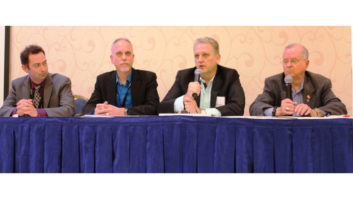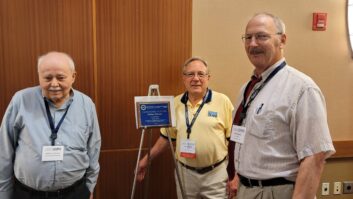Pacifica Radio’s Los Angeles station KPFK(FM), airing at 90.7 MHz, broadcasts in English and Spanish. Unfortunately for some listeners, though, the Spanish programming is only aired 9 p.m. to midnight, Mondays to Thursdays. That’s not exactly prime time, especially in a market that, according to Arbitron, has 4.6 million Hispanics age 12+.
Ideally, Pacifica Radio would add a Spanish-only radio station. But even assuming one were available, Pacifica is a listener-funded network with significant funding challenges.

Alan Minsky This is why KPFK is turning to low-power AM transmitters to reach Hispanic neighborhoods in Los Angeles. The plan, arguably a stop-gap, could bring KPFK’s Spanish programming to at least some Hispanic areas quickly and cheaply.
“With a few LPAM transmitters and antennas, we can cover MacArthur Park,” says KPFK Program Director Alan Minsky. “About 50,000 people work in this area right now. That’s a big audience that can be reached in a very affordable manner.”
The rule
Low-power AM is governed under Part 15 of the FCC rules, in Title 47 of the Federal Code of Regulations.
According to www.fcc.gov, LPAM broadcasts are “limited to an effective service range of approximately 200 feet (61 meters) … These devices must accept any interference caused by any other operation, which may further limit the effective service range.” LPAM transmitters also are limited to an output of 0.1 watt, and their antennas cannot exceed 3 meters in length. (The rules vary somewhat for carrier current and “leaky coax” systems.)
Though such systems might only cover a few blocks, they have two big benefits: they require no license, and they are relatively inexpensive. For example, a Hamilton Rangemaster AM1000C Outdoor Crystal System comes with a Part 15 LPAM transmitter, antenna, mount bracket, Belden wire and meter, all for $850.
“For us, the challenge comes down to finding locations to mount our LPAM transmitters/antennas, and locating open spaces on the AM band,” Minsky told Radio World.
“Fortunately, people are willing to give us access to building space — these LPAM units are small and hardly use any power — and there are lots of open areas on the AM band, especially because the short range of LPAM coverage allows us to reuse the same frequencies around the city.”
The feed
KPFK does not have the budget to create a Spanish-only radio service in-house, but it does have the resources to solve its content problems using the Web.
“Specifically, our plan is to create a 24/7 Spanish-language audio stream,” Minsky says. “It will feature KPFK’s existing Spanish-language programming, bolstered by repeats and content drawn from other sources.”
Once the audio stream is available on the Web, the rest is easy. KPFK installs LPAM transmitters/antennas in its target areas, connects each system to a Web-connected PC audio output, and presto: Instant AM network.
If the site offers antenna locations on two or more faces of a building, the PC’s audio feed can be shared between them. Alternatively, if the LPAM site can receive the KPFK feed off-air on one AM channel, it can retransmit on another. This would reduce equipment costs further.
The plan
In November, KPFK was putting together the content for its Spanish-language audio stream. “Once it is up and running, our first goal is to set up a few LPAM transmitters in the downtown and near-downtown areas of LA.”
This said, Pacific Radio’s ultimate goal is to launch a full-powered Spanish language radio station someday, when that goal becomes economically feasible.
Minsky acknowledges that L.A. is too big to even dream of covering it with an LPAM network.
“We’re well aware of how vast Southern California is,” he says. “The LPAM plan is, at the most, to try to blanket one or two densely populated areas — our first target area is not only a neighborhood with thousands of residents live; but more importantly, a neighborhood where tens of thousands of Spanish language speakers work.”
For Pacifica Radio, LPAM offers an economical if unorthodox venue for serving L.A.’s Spanish-speaking audiences.
“As a socially progressive broadcaster, we offer content to the city’s Hispanic population that no one else has,” Minsky concludes. “We don’t have the money to reach them using HD Radio, which hasn’t had much of a significant uptake anyway. But we can do it with LPAM — and the people we broadcast to have access to AM radios today.”
Radio World e-mailed and called the station in December and January with followup questions including the nature of the antenna, how many transmitters are planned and whether the first ones had been employed. We had not heard back as of press time.
The FCC Office of Engineering and Technology offers a bulletin on its website, “Understanding the FCC Part 15 Regulations for Low-Power, Non-Licensed Transmitters.” Find it at www.fcc.gov/oet/info/documents/bulletins/#63.












